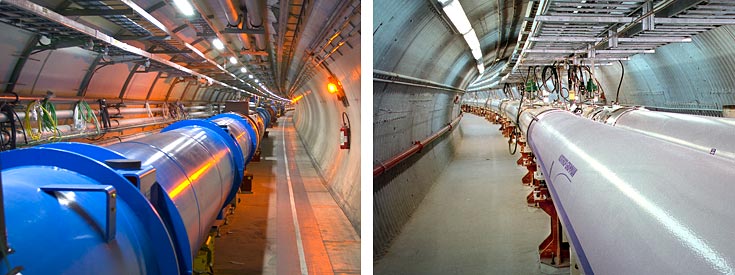




The Relativistic Heavy Ion Collider (RHIC /ˈrɪk/) is the first and one of only two operating heavy-ion colliders, and the only spin-polarized proton collider ever built. Located at Brookhaven National Laboratory (BNL) in Upton, New York, and used by an international team of researchers, it is the only operating particle collider in the US.
RHIC began operation in 2000 and until November 2010 was the most powerful heavy-ion collider in the world. The Large Hadron Collider (LHC) of CERN, while used mainly for colliding protons, operates with heavy ions for about one month per year. The LHC has operated with 25 times higher energies per nucleon. As of 2017 RHIC and the LHC are the only operating hadron colliders in the world.
"Scientists from the U.S. Department of Energy’s Brookhaven National Laboratory helped design and build key components of the LHC, and collaborate on research at the ATLAS detector, one of the LHC’s two large high-energy physics experiments that, in 2012, announced the discovery of the Higgs boson. Brookhaven serves as the United States’ host laboratory for ATLAS collaborators across the nation, and handles a large amount of the data processing and distribution to ATLAS collaborators around the world.
Brookhaven physicists also participate in the LHC’s Heavy Ion Program at ATLAS, analyzing results from collisions of large nuclei such as lead, much like the gold-gold collisions at Brookhaven’s own Relativistic Heavy Ion Collider (RHIC), but at a higher energy. RHIC and the LHC work in complementary ways to explore details of the quark-gluon plasma (QGP) that existed in the very early universe in an effort to understand its properties over a range of energies and how it evolved to form the visible matter of the universe today."
https://www.bnl.gov/rhic/news2/news.asp?a=6528&t=today
The PHENIX detector (for Pioneering High Energy Nuclear Interaction eXperiment) is the largest of the four experiments that have taken data at the Relativistic Heavy Ion Collider(RHIC) in Brookhaven National Laboratory, United States.
PHOBOS (not an acronym - named for Mars' moon)
We worked at Brookhaven for five years with PHOBOS, learned a fair amount, and now my group has moved to CERN, to the LHC, where we will shortly be looking at collisions of lead on lead at unprecedented energy. We're part of the CMS (Compact Muon Solenoid) detector.
Well, we first proposed a slightly more expensive experiment called the Modular Array for RHIC Spectra, or MARS. That was considered too expensive, so we came up with a reduced version and one of my colleagues at MIT said that, since Mars was too expensive, why not build the moon of Mars, which is Phobos. And if that was still considered too expensive, we figured we'd come up with Deimos, a still smaller moon of Marshttp://archive.sciencewatch.com/ana/st/ ... rSThadBNL/
-"PHOBOS had begun as a larger project called Mars before RHIC went into operation. When Mars was scaled back, the project was renamed after one of the planet's moons."
https://www.phenix.bnl.gov/WWW/lists/phenix-news-l/msg01193.html
Relativistic Heavy Ion Group (HIG)
This group led the PHOBOS experiment at BNL, which concluded data collection in 2005This group now takes a leading role in the heavy-ion program of the Compact Muon Solenoidal (CMS) experiment at the Large Hadron Collider (LHC) at CERN. The LHC is capable of colliding lead ions at the energy about 30 times higher than RHIC. The CMS experiment will examine this perfect liquid of quarks and gluons at much higher temperatures and explore different parts of the phase diagram. The CMS experiment collected lead-lead collision data in November 2010.
http://web.mit.edu/lns/research/heavyion.html

Another phoenix or phenix, fenix underground that represents Mars stargate...

RHIC was activated June 12, 2000 with the STAR and PHOBOS (Mars) detectors marking the first ever heavy ion collisions:
The Relativistic Heavy Ion Collider is the first and one of only two operating heavy-ion colliders, and the only spin-polarized proton collider ever built.
Relativistic Heavy Ion Collider (RHIC) Begins Smashing Atoms
https://www.bnl.gov/rhic/news2/news.asp?a=1052&t=prThe first collisions have been detected at the Relativistic Heavy Ion Collider (RHIC) at the Brookhaven National Laboratory in the US. The STAR detector recorded the first collisions at 9pm local time on Monday, while the PHOBOS detector recorded its first events early on Tuesday. The first physics results from RHIC are expected at the beginning of next year.http://physicsworld.com/cws/article/news/2000/jun/14/rhic-makes-its-debut
- June 15, 2000 at 6:28 am EDT: PHENIX records its first relativistic heavy ion collision.
June 4, 2000:
Indonesia is well known for strong earthquakes: the 2000 Enggano event marked the beginning of an ongoing period of seismic activity in the area, highlighted by the 2004 Indian Ocean earthquake.
Two weeks later on June 18, another magnitude 7.9 event occurred about 1,000 kilometers (620 mi) to the southwest in the Wharton Basin. At the time, it was the largest intraplate earthquake in the Indian Ocean.[12]
https://en.wikipedia.org/wiki/List_of_earthquakes_in_2000#June
The Relativistic Heavy Ion Collider (RHIC /ˈrɪk/) is the first and one of only two operating heavy-ion colliders, and the only spin-polarized proton collider ever built.The first ever heavy ion collision took place inside the STAR detector in 2000(y2k) followed by "Phobos"/Mars and Phenix... Connecting the first use of this technology with "star gate"
"STARGATE" framework/processor




No comments:
Post a Comment